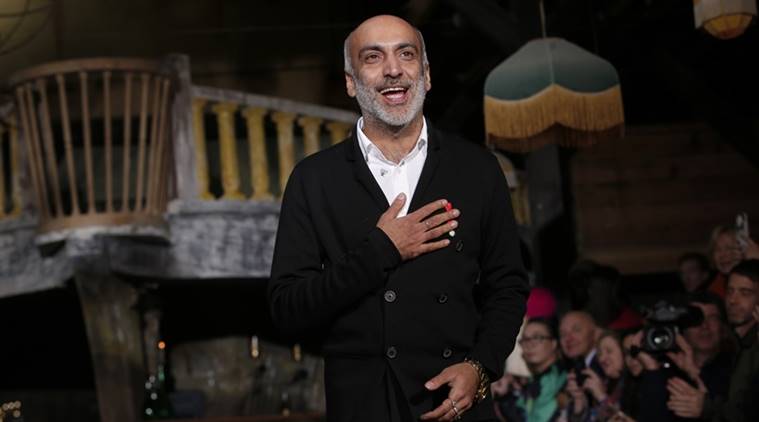Manish Arora was the blow out fashion star of India. Today, his business is in tatters, with a trail of debts.

his messy downfall has also been particularly disappointing for those who had hoped he would help bring international attention to the quieter but vital layers of the Indian fashion industry — like the anonymous artisans (called karigars) who are responsible for much of the meticulous and beautiful handwork that goes into the garments.
“Fifteen years ago, Manish was almost seen like a god here for being the first Indian fashion designer to break into the global luxury market,” said Sunil Sethi, the president of the Fashion Design Council of India. European high fashion, after all, is famously white and set in its ways, and until recently known more for appropriating ideas from other cultures rather than embracing and celebrating ethnically diverse designers and artisans.
“Big international brand names wanted to collaborate with him,” Mr. Sethi said. “We were just so proud. And as the international fashion industry looked at Indian talent in a new light, we wondered whether more Indian designers would follow in his footsteps to the catwalks of Europe.”
Instead, today, Mr. Arora’s brand has been felled by business deals gone bad, unpaid wages lawsuits, and vendor disputes that started at least three years ago, long before the coronavirus dealt the final blow. Earlier this year, Mr. Arora, who is in his late 40s, parted ways with his business partner of several decades, Deepak Bhagwani. Currently, the Manish Arora website is shut for maintenance.

The brand’s last runway show, for spring 2020, was shown a year ago, and pieces that are available to buy are largely discounted, from past seasons and on sale via small, independent boutiques in the Middle East and Asia. The Manish Arora store in Paris has closed, and in messages seen by The New York Times, employees who asked the company about unpaid wages in October were told none would be forthcoming because the company was now in liquidation. According to Mr. Bhagwani, 43, the French holding company for Mr. Arora’s Indian subsidiary went into liquidation in July.
Mr. Arora, reached by email in mid-October, declined to discuss the particulars of the situation. He said there was “acute disappointment” among all parties” and that he did not want to comment “on what went wrong given we are in liquidation and also the matter is in court.”
“We expanded and hoped to reach the world with our unique sensibility and we tried. Sincerely,” Mr. Arora wrote. “Unfortunately things went wrong. The markets shrunk. Expenses mounted and we soldiered on to the best of our capabilities.”
For the moment, he added, he was “reassessing the way forward.” That does not help, however, those he has left behind.
The Fashion Hope of India
Mr. Arora started out with big, global ambitions. But the same forces that have strangled other independent designer businesses — chronic discounting from retailers, outrageously expensive fashion shows, overproduction of items nobody wanted — also affected him. And instead of prioritizing responsibilities to longtime employees, it seemed Manish Arora management opted to chase profits and keep up appearances.
Then the pandemic began to ravage India’s fashion industry. As Western retailers canceled orders and the Indian government abruptly locked down the country on March 24, Mr. Arora and his partners had started closing their business.
It also came at a time when consumer attitudes toward fashion businesses that fail to pay workers are changing — and employees are increasingly willing to speak up, said Sanchita Banerjee Saxena, the executive director for the Institute for South Asia Studies at the University of California at Berkeley.
Also tangled up in the mismanagement at Manish Arora were middle-class professionals in office jobs. In seven interviews with The New York Times, those professionals, along with karigars and vendors, all told a nearly identical story.
“All Indian designers need to understand the fact that in order to excel in the international market, we all have to focus on the modernity of the garment and not on the Western look,” Mr. Arora told the critic Suzy Menkes in 2009. “This means that we have to take Western ideas and use Indian sensibilities to make it a global product.”
At its peak, Manish Arora was sold by retailers like Printemps, Yoox, Saks Fifth Avenue, Selfridges, Neiman Marcus, and Galeries Lafayette. The Delhi-based production arm, incorporated as a separate company called Three Clothing Private Limited, employed 200 people.
Behind the Gilded Curtain
While Mr. Arora’s business appeared to flourish abroad, however, it struggled to grow at home, according to former office staff and artisans. In 2012, the Indian fashion company Biba took a 51 percent stake in order to help Mr. Arora expand Indian by Manish Arora, which, among other lines, included a neon-colored couture bridal collection for the domestic market.
By mid-2017, Indian by Manish Arora had shut down. According to Aftab Alam, 45, a master leatherworker and former employee, and Omveer Singh, 40, who worked in accounting and marketing, it was also the year that everything started falling apart.
Partnerships with important stores started to dry up. According to Mr. Alam and Mr. Singh, employees began to be paid late, first by a few days, then a few weeks.
Empty Promises
Artisans and production workers unionized in 2016. But before office staff had been paid, former employees said, Mr. Arora would ask for money transfers to his personal account to pay for his vacations on top of his salary and the cost of his apartment and living expenses.
According to Mr. Alam, Mr. Arora also had the artisans make up to a dozen elaborate Burning Man outfits for him, a task Mr. Alam said took three artisans up to 20 days, at a time when they were still owed considerable sums for regular work and knew that the business was in trouble. In late 2017, Mr. Arora and Mr. Bhagwani left to go on their annual New Year’s jaunt to Goa, a beachside party destination on the west coast of India, posting their exploits on their Instagram stories, which were watched by their employees. Salaries were several months late.

